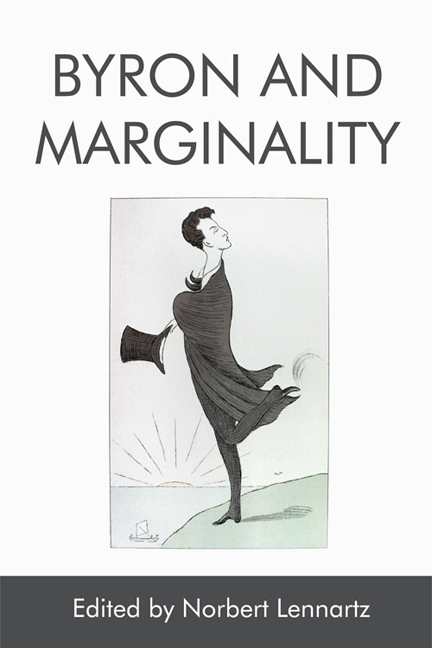Book contents
- Frontmatter
- Contents
- Foreword
- Acknowledgements
- Editions and Abbreviations
- 1 Lord Byron, Wandering and Wavering between the Centres and Margins of Romanticism: An Attempt at an Introduction
- I Byron’s Marginalisation in Romantic World Literature
- II Byron’s Marginal Identities and Places
- III Cherishing the Marginal – Marginal Genres in Byron
- IV On the Provocative Margins of Taste
- V Marginal Affairs – Visual and Paratextual Aspects in Byron
- List of Contributors
- Index
4 - Byron and Romantic Period Neoclassicism
Published online by Cambridge University Press: 06 May 2021
- Frontmatter
- Contents
- Foreword
- Acknowledgements
- Editions and Abbreviations
- 1 Lord Byron, Wandering and Wavering between the Centres and Margins of Romanticism: An Attempt at an Introduction
- I Byron’s Marginalisation in Romantic World Literature
- II Byron’s Marginal Identities and Places
- III Cherishing the Marginal – Marginal Genres in Byron
- IV On the Provocative Margins of Taste
- V Marginal Affairs – Visual and Paratextual Aspects in Byron
- List of Contributors
- Index
Summary
In the Romantic period, the margins or borderlines separating Romanticism from Neoclassicism were not clearly defined, any more than the margins defining Christianity against Paganism in the fourth century ad. There was a medley of voices, with authors repeatedly changing positions, until, after decades of heated debates, they were post festum summarised under two opposed groups, whose margins or borderlines of inclusion and exclusion were nevertheless broad and permeable. Analogously, Romantic period poets could change and even mix modes, as did, for instance, Percy Bysshe Shelley's sometime friend and sometime adversary Thomas Love Peacock, the famous Greek scholar and Neoclassicist who, in his verse tale Rhododaphne (1818), mixed Classical legend with Romantic magic. He was a chameleon and border-crosser who obviously enjoyed his repeated changes of role, and was fascinated by Classical Greek and Roman tales and legends featuring changes (such as Ovid's Metamorphoses and Apuleius’ Golden Ass).
In accordance with David Hume's sceptical philosophy of identity, Byron was also a chameleon – so called by Lady Blessington – in many respects. Radical Whig in the House of Lords and Cambridge, yet a Tory in Albemarle Street and fine society, a writer alternately in the Romantic and Neoclassical modes, he created a Byronic hero who was, in turn, alternately noble and criminal, rational and sensitive. In a letter to his young confidante, Elizabeth Pigot, in which he implicitly admitted his penchant for adolescent boys, the nineteen-year-old lord honestly confessed his ‘(in general) changeable Disposition’. The characters of Arnold and Caesar, from Byron's unfinished doppelgänger drama The Deformed Transformed (1824), in which he modelled Caesar on Goethe's Mephistopheles, represent the ever-changing sides of Byron's personality, alternating roles played seriously. Numerous biographical and psychoanalytical studies have tried to account for this bewildering complexity, especially in view of his central theme of the fall of man and expulsion from Paradise. Byron's Romantic disillusionism has been related to his early experience with his mother, who alternately loved and hated him as she both loved and hated his runaway father. Illusions of Paradise were inevitably followed by the reality of Paradise Lost. The dialectical synthesis of Paradise Regained then proved to be just another illusion followed by another experience of loss, constituting an absurd circle rather than a spiral ascent.
- Type
- Chapter
- Information
- Byron and Marginality , pp. 57 - 74Publisher: Edinburgh University PressPrint publication year: 2018



